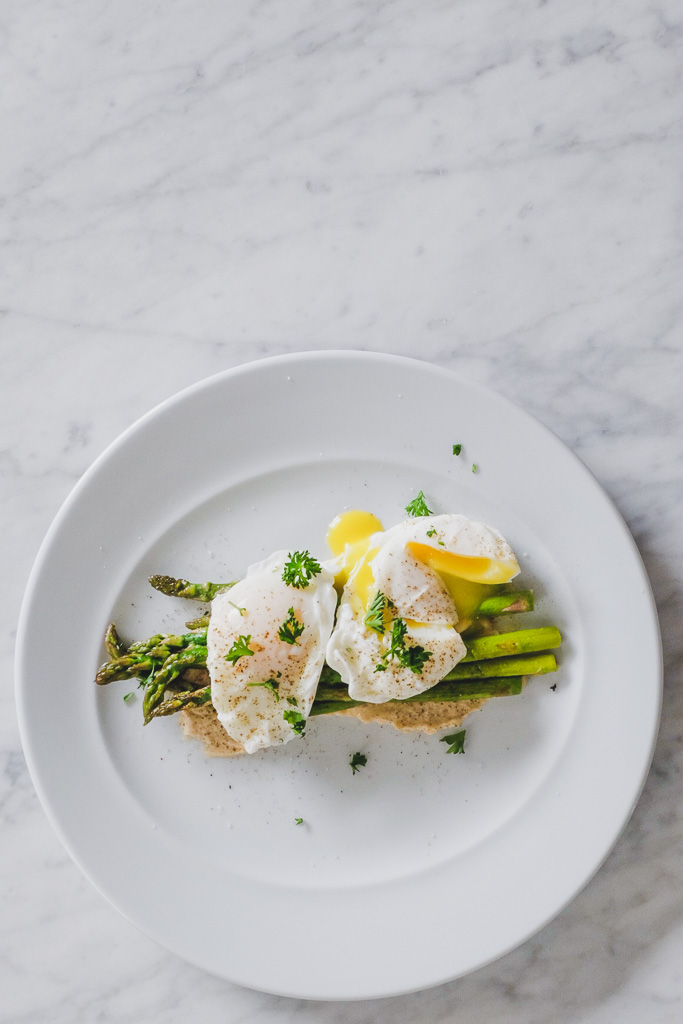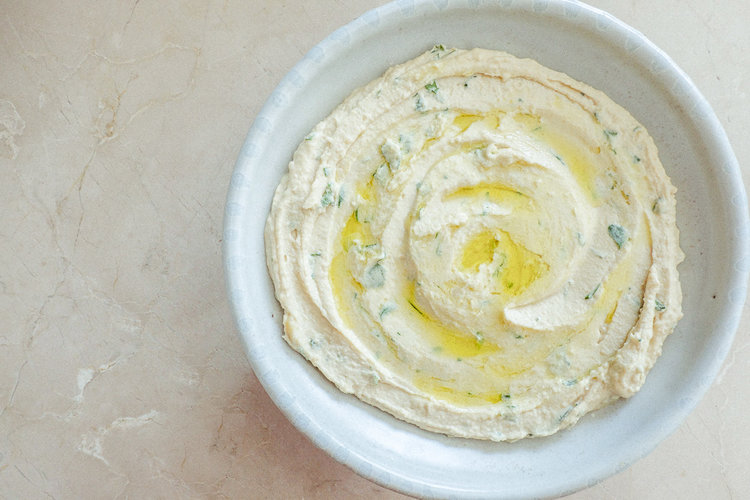Full disclosure… I created this recipe by accident. My sole focus was to use up some sad asparagus in my fridge, and I was pleasantly surprised. I often pair hummus with my eggs, because I love the way it tastes with the yolk, so I pretty much always have some homemade on-hand.

Maybe it’s just us, but it always seems like the standard asparagus bundle is too much for one meal, and too little for two. Evan and I are very reluctant to throw anything out, and it always seems to be those 6-8 asparagus stalks that are going bad in our fridge. This is a perfect recipe to make use of those extra bits of veg you have sitting around. If it’s red pepper, mushrooms, or even an onion, try a version of this recipe and see if you like it! And, since it’s pan-fried, it’s not the end of the world if they’re a little bit wilted, to begin with. Perhaps your greens aren’t crisp enough for a salad but are good enough to sauté. Substitute oil for butter, and go for it! And if you’re not a fan of poached eggs, you can always fry. If you don’t like soft, poach them hard. That’s the beauty of cooking in your own home… you have complete control!
The flavours in this dish are simple, so I recommend using homemade hummus and grass-fed butter. I like my hummus heavy on tahini and mild in salt. I prefer it to be rich, creamy, and a catalyst for other flavours, but I find store-bought often overpowers. As for grass-fed butter… it’s basically the price of gold, but it’s worth it. For whatever reason, grass-fed butter tastes so much better than conventional, and that flavour is SO good in this dish. We always cringe when we swipe the card for this stuff (about $10 for half a pound), but we’re committed. I love feeling good about what I’m buying/eating, and it’s a total bonus that it tastes amazing. We just try to eat less butter, to make up for the price! Something we’ve been relatively unsuccessful at, thus far…

If you’re going with homemade hummus, skinning the chickpeas will make for a creamier texture. You don’t have to do this, but I definitely recommend it. If you’re using canned chickpeas, the process of skinning each one individually is doable but tiresome. Even though it might seem like more work to use dried chickpeas, soaking them overnight and cooking them for approximately 20-40 minutes is low maintenance in comparison. Plus, they honestly do taste SO much better. If you choose to take this route, the skins will release on their own and you can scoop them out of the water as they do. At the end of the day, it’s all about preference.
This recipe is a bit of an excuse to share some tricks I’ve picked up from a couple different cookbooks, so please, bear with me and read on… You might just learn a new thing, or two!
Poached Eggs over Pan-Fried Asparagus with Hummus
Ingredients
- 2 eggs
- Approx. 6 Asparagus Stalks, ends removed
- 1 tbsp Butter, Ideally Grass-fed
- 1/4 Cup Homemade Hummus, or preferred brand
- Salt + Pepper to taste
- Parsley, for garnish (optional)
Instructions
- NOTE: I do not use the vinegar method to poach, as it leaves too much flavour in my eggs, and I don’t love the taste of vinegar. Also, it’s important to disturb the water as the eggs cook. Otherwise, they will not finish as plump and round, and will potentially overcook near the bottom. J. Kenzi Lopez-Alt’s book, “The Food Lab”, describes a brilliant method for poaching eggs using a fine mesh strainer, which I will describe along with an alternative technique if you do not have one available.
- In a large saucepan, combine a substantial amount of water and a generous amount of salt, and bring to a boil.
- Meanwhile, heat a pan over medium heat and add butter. Once butter’s foam begins to taper, add asparagus and toss for approximately 30 seconds, before turning heat down to medium-low. Cover and continue to cook for approximately 1-2 minutes, or until slightly firmer than desired texture. Salt + pepper to taste, remove the pan from heat, and leave covered until ready to serve.
- Reduce boiling water to a low steady simmer. Crack one egg into a small bowl or cup and carefully transfer to a mesh strainer. Some whites will fall through the strainer and separate. Allow this to happen, shaking it slightly, then carefully submerge mesh strainer into simmering water and tip to release the egg. There should be minimal separation. Repeat with the second egg.
- IF YOU DO NOT HAVE A MESH STRAINER, swirl simmering water and very carefully add the egg, pouring straight from small cup or bowl. Immediately begin to fold any separating whites over the egg. Repeat the process with the second egg.
- Continue to cook eggs, swirling water occasionally. After approximately 3 minutes, whites should be cooked and yolks soft. Remove from water with a slotted spoon and set aside on cloth covered plate to dry slightly.
- Spread hummus along plate, layer with asparagus, and top with poached eggs. Add salt+pepper to taste, and garnish with parsley.
Homemade Hummus
Ingredients
- 1 Cup Dried Chickpeas, 2 cups, if canned
- 1 Tsp Baking Soda
- 6 Cups Water
- 1/4 Cup Lemon Juice
- 4 Medium Garlic Cloves
- 1/2 Cup Tahini
- 1/2 Cup Ice Cold Water
- 1 Tsp Salt
- 1 Tbsp Olive Oil
- 1/3 Cup Parsley, chopped
Instructions
- This technique of soaking and cooking chickpeas comes from Yotam Ottolenghi’s cookbook, “Jerusalem: A Cookbook”. A fantastic cookbook, I might add. This hummus recipe is an adaptation of his basic hummus, to which I made some small adjustments to fit my taste. I like to either drizzle or fold in olive oil at the end for texture and flavour, but this is optional.
- IF USING DRIED CHICKPEAS, START HERE…
- In a bowl, cover chickpeas with twice their volume of water. Let soak overnight.
- After about 12 hours, heat chickpeas and baking soda over high heat, in a saucepan. Cook and stir for approximately 3 minutes, before adding 6 cups of water to the pan. Bring to a boil, then reduce to simmer and let cook, removing skins as they float to the surface. After approximately 20-40 minutes, the chickpeas should be soft and very easy to crush with your fingers. Check them frequently as they cook, within this timeframe.
- IF USING CANNED CHICKPEAS (PREFERABLY SKINNED), START HERE…
- Pour drained chickpeas into a food processor and blend until smooth. If you have extra chickpeas, adjust tahini/lemon/water ratio slightly or reserve them to fold into the hummus at the end of the process, to add some dimension to the texture.Continue to run the food processor, adding ice cold water, lemon juice, garlic, tahini paste, and salt, in that order. If you have a finicky food processor or are using a blender, I find this helps to keep the hummus smooth, making it easier to mix. Taste and adjust flavouring to your liking.
- Remove hummus from the food processor, fold in parsley, and drizzle with olive oil to serve.
Leave a Reply